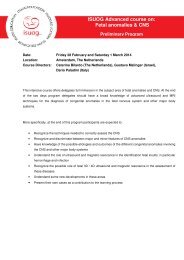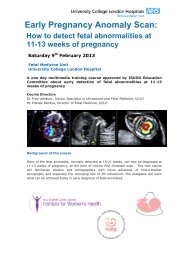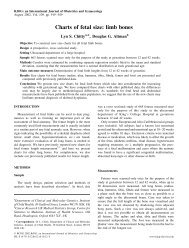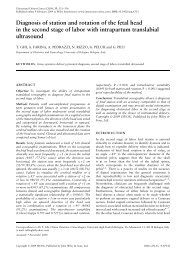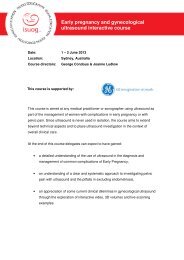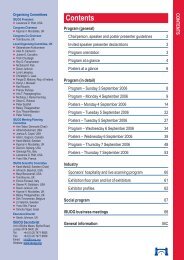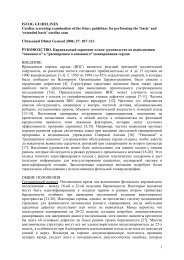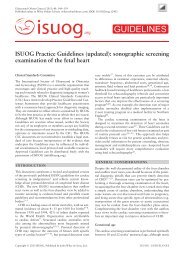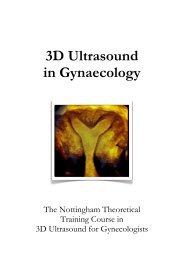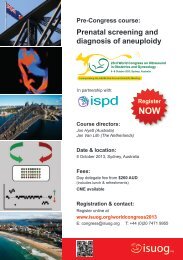use of Doppler ultrasonography in obstetrics - isuog
use of Doppler ultrasonography in obstetrics - isuog
use of Doppler ultrasonography in obstetrics - isuog
Create successful ePaper yourself
Turn your PDF publications into a flip-book with our unique Google optimized e-Paper software.
Ultrasound Obstet Gynecol 2013; 41: 233–239<br />
Published onl<strong>in</strong>e <strong>in</strong> Wiley Onl<strong>in</strong>e Library (wileyonl<strong>in</strong>elibrary.com). DOI: 10.1002/uog.12371<br />
<strong>isuog</strong>.org<br />
GUIDELINES<br />
ISUOG Practice Guidel<strong>in</strong>es: <strong>use</strong> <strong>of</strong> <strong>Doppler</strong> <strong>ultrasonography</strong><br />
<strong>in</strong> <strong>obstetrics</strong><br />
Cl<strong>in</strong>ical Standards Committee<br />
The International Society <strong>of</strong> Ultrasound <strong>in</strong> Obstetrics<br />
and Gynecology (ISUOG) is a scientific organization that<br />
encourages sound cl<strong>in</strong>ical practice, teach<strong>in</strong>g and research<br />
related to diagnostic imag<strong>in</strong>g <strong>in</strong> women’s healthcare. The<br />
ISUOG Cl<strong>in</strong>ical Standards Committee (CSC) has a remit<br />
to develop Practice Guidel<strong>in</strong>es and Consensus Statements<br />
as educational recommendations that provide healthcare<br />
practitioners with a consensus-based approach for<br />
diagnostic imag<strong>in</strong>g. They are <strong>in</strong>tended to reflect what is<br />
considered by ISUOG to be the best practice at the time at<br />
which they are issued. Although ISUOG has made every<br />
effort to ensure that Guidel<strong>in</strong>es are accurate when issued,<br />
neither the Society nor any <strong>of</strong> its employees or members<br />
accepts any liability for the consequences <strong>of</strong> any <strong>in</strong>accurate<br />
or mislead<strong>in</strong>g data, op<strong>in</strong>ions or statements issued<br />
by the CSC. They are not <strong>in</strong>tended to establish a legal<br />
standard <strong>of</strong> care beca<strong>use</strong> <strong>in</strong>terpretation <strong>of</strong> the evidence<br />
that underp<strong>in</strong>s the Guidel<strong>in</strong>es may be <strong>in</strong>fluenced by <strong>in</strong>dividual<br />
circumstances and available resources. Approved<br />
Guidel<strong>in</strong>es can be distributed freely with the permission<br />
<strong>of</strong> ISUOG (<strong>in</strong>fo@<strong>isuog</strong>.org).<br />
SCOPE OF THE DOCUMENT<br />
This document summarizes Practice Guidel<strong>in</strong>es regard<strong>in</strong>g<br />
how to perform <strong>Doppler</strong> <strong>ultrasonography</strong> <strong>of</strong> the fetoplacental<br />
circulation. It is <strong>of</strong> utmost importance not to<br />
expose the embryo and fetus to unduly harmful ultrasound<br />
energy, particularly <strong>in</strong> the earliest stages <strong>of</strong> pregnancy. At<br />
these stages, <strong>Doppler</strong> record<strong>in</strong>g, when cl<strong>in</strong>ically <strong>in</strong>dicated,<br />
should be performed at the lowest possible energy levels.<br />
ISUOG has published guidance on the <strong>use</strong> <strong>of</strong> <strong>Doppler</strong><br />
ultrasound at the 11 to 13+6-week fetal ultrasound<br />
exam<strong>in</strong>ation 1 . When perform<strong>in</strong>g <strong>Doppler</strong> imag<strong>in</strong>g, the<br />
displayed thermal <strong>in</strong>dex (TI) should be ≤ 1.0 and exposure<br />
time should be kept as short as possible, usually no<br />
longer than 5–10 m<strong>in</strong> and not exceed<strong>in</strong>g 60 m<strong>in</strong> 1 .<br />
It is not the <strong>in</strong>tention <strong>of</strong> these Guidel<strong>in</strong>es to def<strong>in</strong>e<br />
cl<strong>in</strong>ical <strong>in</strong>dications, specify proper tim<strong>in</strong>g <strong>of</strong> <strong>Doppler</strong><br />
exam<strong>in</strong>ation <strong>in</strong> pregnancy or discuss how to <strong>in</strong>terpret<br />
f<strong>in</strong>d<strong>in</strong>gs or the <strong>use</strong> <strong>of</strong> <strong>Doppler</strong> <strong>in</strong> fetal echocardiography.<br />
The aim is to describe pulsed <strong>Doppler</strong> ultrasound and<br />
its different modalities: spectral <strong>Doppler</strong>, color flow mapp<strong>in</strong>g<br />
and power <strong>Doppler</strong>, which are commonly <strong>use</strong>d to<br />
study the maternal–fetal circulation. We do not describe<br />
the cont<strong>in</strong>uous wave <strong>Doppler</strong> technique, beca<strong>use</strong> this is<br />
not usually applied <strong>in</strong> obstetric imag<strong>in</strong>g; however, <strong>in</strong><br />
cases <strong>in</strong> which the fetus has a condition lead<strong>in</strong>g to very<br />
high-velocity blood flow (e.g. aortic stenosis or tricuspid<br />
regurgitation) it might be helpful <strong>in</strong> order to def<strong>in</strong>e clearly<br />
the maximum velocities by avoid<strong>in</strong>g alias<strong>in</strong>g.<br />
The techniques and practices described <strong>in</strong> these Guidel<strong>in</strong>es<br />
have been selected to m<strong>in</strong>imize measurement errors<br />
and improve reproducibility. They may not be applicable<br />
<strong>in</strong> certa<strong>in</strong> specific cl<strong>in</strong>ical conditions or for research<br />
protocols.<br />
RECOMMENDATIONS<br />
What equipment is needed for <strong>Doppler</strong> evaluation <strong>of</strong><br />
the fetoplacental circulation?<br />
• Equipment should have color flow and spectral wave<br />
<strong>Doppler</strong> capabilities with onscreen display <strong>of</strong> flow<br />
velocity scales or pulse repetition frequency (PRF) and<br />
<strong>Doppler</strong> ultrasound frequency (<strong>in</strong> MHz).<br />
• Mechanical <strong>in</strong>dex (MI) and TI should be displayed on<br />
the ultrasound screen.<br />
• Ultrasound system should generate a maximum velocity<br />
envelope (MVE) show<strong>in</strong>g the whole spectral <strong>Doppler</strong><br />
waveform.<br />
• MVE should be possible to del<strong>in</strong>eate us<strong>in</strong>g automatic<br />
or manual waveform traces.<br />
• System s<strong>of</strong>tware must be able to estimate peak systolic<br />
velocity (PSV), end-diastolic velocity (EDV) and<br />
time-averaged maximum velocity from the MVE and<br />
to calculate the commonly <strong>use</strong>d <strong>Doppler</strong> <strong>in</strong>dices i.e.<br />
pulsatility (PI) and resistance (RI) <strong>in</strong>dices and systolic/diastolic<br />
velocity (S/D) ratio. On the trac<strong>in</strong>g, the<br />
various po<strong>in</strong>ts <strong>in</strong>cluded <strong>in</strong> the calculations should be<br />
<strong>in</strong>dicated, to ensure correctly calculated <strong>in</strong>dices.<br />
How can the accuracy <strong>of</strong> <strong>Doppler</strong> measurements be<br />
optimized?<br />
Pulsed wave <strong>Doppler</strong> <strong>ultrasonography</strong><br />
• Record<strong>in</strong>gs should be obta<strong>in</strong>ed dur<strong>in</strong>g absence <strong>of</strong> fetal<br />
breath<strong>in</strong>g and body movements, and if necessary dur<strong>in</strong>g<br />
temporary maternal breath hold.<br />
Copyright © 2013 ISUOG. Published by John Wiley & Sons, Ltd.<br />
ISUOG GUIDELINES
234 ISUOG Guidel<strong>in</strong>es<br />
• Color flow mapp<strong>in</strong>g is not mandatory, although it is<br />
very helpful <strong>in</strong> the identification <strong>of</strong> the vessel <strong>of</strong> <strong>in</strong>terest<br />
and <strong>in</strong> def<strong>in</strong><strong>in</strong>g the direction <strong>of</strong> blood flow.<br />
• The optimal <strong>in</strong>sonation is complete alignment with the<br />
blood flow. This ensures the best conditions for assess<strong>in</strong>g<br />
absolute velocities and waveforms. Small deviations<br />
<strong>in</strong> angle may occur. An <strong>in</strong>sonation angle <strong>of</strong> 10 ◦ corresponds<br />
to a 2% velocity error whilst a 20 ◦ angle<br />
corresponds to 6% error. When absolute velocity is<br />
the cl<strong>in</strong>ically important parameter (e.g. middle cerebral<br />
artery (MCA)) and an angle <strong>of</strong> > 20 ◦ is obta<strong>in</strong>ed, angle<br />
correction may be <strong>use</strong>d, but this <strong>in</strong> itself may lead to<br />
error. In this case, if the record<strong>in</strong>g is not improved by<br />
repeated <strong>in</strong>sonations, a statement should be added to<br />
any report stat<strong>in</strong>g the angle <strong>of</strong> <strong>in</strong>sonation and whether<br />
angle correction was carried out or that the uncorrected<br />
velocity is recorded.<br />
• It is advisable to start with a relatively wide <strong>Doppler</strong><br />
gate (sample volume) to ensure the record<strong>in</strong>g <strong>of</strong> maximum<br />
velocities dur<strong>in</strong>g the entire pulse. If <strong>in</strong>terference<br />
from other vessels ca<strong>use</strong>s problems the gate can be<br />
reduced to ref<strong>in</strong>e the record<strong>in</strong>g. Keep <strong>in</strong> m<strong>in</strong>d that the<br />
sample volume can be reduced only <strong>in</strong> height, not <strong>in</strong><br />
width.<br />
• Similar to gray-scale imag<strong>in</strong>g, the penetration and resolution<br />
<strong>of</strong> the <strong>Doppler</strong> beam can be optimized by<br />
adjust<strong>in</strong>g the frequency (MHz) <strong>of</strong> the <strong>Doppler</strong> probe.<br />
• The vessel wall filter, alternatively called ‘low velocity<br />
reject’, ‘wall motion filter’ or ‘high pass filter’, is<br />
<strong>use</strong>d to elim<strong>in</strong>ate noise from the movement <strong>of</strong> the vessel<br />
walls. By convention, it should be set as low as<br />
possible (≤ 50–60 Hz) <strong>in</strong> order to elim<strong>in</strong>ate the lowfrequency<br />
noise from peripheral blood vessels. When<br />
us<strong>in</strong>g a higher filter, a spurious effect <strong>of</strong> absent EDV<br />
can be created (see Figure 4b).<br />
• A higher wall filter is <strong>use</strong>ful for a well-def<strong>in</strong>ed MVE<br />
from structures like the aortic and pulmonary outflow<br />
tracts. A lower wall filter might ca<strong>use</strong> noise, appear<strong>in</strong>g<br />
as flow artifacts close to the basel<strong>in</strong>e or after valve<br />
closures.<br />
• <strong>Doppler</strong> horizontal sweep speed should be fast enough<br />
to separate successive waveforms. Ideal is a display <strong>of</strong><br />
four to six (but no more than eight to 10) complete<br />
cardiac cycles. For fetal heart rates <strong>of</strong> 110–150 bpm, a<br />
sweep speed <strong>of</strong> 50–100 mm/s is adequate.<br />
• PRF should be adjusted accord<strong>in</strong>g to the vessel studied:<br />
low PRF will enable visualization and accurate<br />
measurement <strong>of</strong> low velocity flow; however, it will produce<br />
alias<strong>in</strong>g when high velocities are encountered. The<br />
waveform should fit at least 75% <strong>of</strong> the <strong>Doppler</strong> screen<br />
(see Figure 3).<br />
• <strong>Doppler</strong> measurements should be reproducible. If there<br />
is obvious discrepancy between measurements, a repeat<br />
record<strong>in</strong>g is recommended. Conventionally, the measurement<br />
closest to the expected is chosen for the report<br />
unless it is technically <strong>in</strong>ferior.<br />
• In order to <strong>in</strong>crease the quality <strong>of</strong> <strong>Doppler</strong> record<strong>in</strong>gs,<br />
a frequent update <strong>of</strong> the real-time gray-scale or<br />
color <strong>Doppler</strong> image should be performed (i.e. after<br />
confirm<strong>in</strong>g <strong>in</strong> the real-time image that the <strong>Doppler</strong><br />
gate is positioned correctly, the two-dimensional (2D)<br />
and/or color <strong>Doppler</strong> image should be frozen when the<br />
<strong>Doppler</strong> waveforms are be<strong>in</strong>g recorded).<br />
• Ensure a correct position and optimize the <strong>Doppler</strong><br />
record<strong>in</strong>g <strong>of</strong> the frozen 2D image by listen<strong>in</strong>g to the<br />
audible representation <strong>of</strong> the <strong>Doppler</strong> shift over the<br />
loudspeaker.<br />
• Ga<strong>in</strong> should be adjusted <strong>in</strong> order to see clearly the<br />
<strong>Doppler</strong> velocity waveform, without the presence <strong>of</strong><br />
artifacts <strong>in</strong> the background <strong>of</strong> the display.<br />
• It is advisable not to <strong>in</strong>vert the <strong>Doppler</strong> display on<br />
the ultrasound screen. In the evaluation <strong>of</strong> the fetal<br />
heart and central vessels it is very important to ma<strong>in</strong>ta<strong>in</strong><br />
the orig<strong>in</strong>al direction <strong>of</strong> the color flow and pulsed<br />
wave <strong>Doppler</strong> display. Conventionally, flow towards<br />
the ultrasound transducer is displayed as red and the<br />
waveforms are above the basel<strong>in</strong>e on the MVE, whereas<br />
flow away from the transducer is displayed as blue and<br />
the waveforms are below the basel<strong>in</strong>e.<br />
Color directional <strong>Doppler</strong> <strong>ultrasonography</strong><br />
• As compared with gray-scale imag<strong>in</strong>g, color <strong>Doppler</strong><br />
<strong>in</strong>creases the total power emitted. Color <strong>Doppler</strong> resolution<br />
<strong>in</strong>creases when the color box is reduced <strong>in</strong> size.<br />
Care must be taken <strong>in</strong> assess<strong>in</strong>g the MI and TI as they<br />
change accord<strong>in</strong>g to the size and depth <strong>of</strong> the color box.<br />
• Increas<strong>in</strong>g the size <strong>of</strong> the color box also <strong>in</strong>creases the<br />
process<strong>in</strong>g time and thus reduces frame rate; the box<br />
should be kept as small as possible to <strong>in</strong>clude only the<br />
studied area.<br />
• The velocity scale or PRF should be adjusted to represent<br />
the real color velocity <strong>of</strong> the studied vessel.<br />
When the PRF is high, low-velocity vessels will not be<br />
displayed on the screen. When a low PRF is applied<br />
<strong>in</strong>correctly, alias<strong>in</strong>g will present as contradictory color<br />
velocity codes and ambiguous flow direction.<br />
• As for gray-scale imag<strong>in</strong>g, color <strong>Doppler</strong> resolution<br />
and penetration depend on the ultrasound frequency.<br />
The frequency for the color <strong>Doppler</strong> mode should be<br />
adjusted to optimize the signals.<br />
• Ga<strong>in</strong> should be adjusted <strong>in</strong> order to prevent noise and<br />
artifacts represented by random display <strong>of</strong> color dots <strong>in</strong><br />
the background <strong>of</strong> the screen.<br />
• Filter should also be adjusted to exclude noise from the<br />
region studied.<br />
• The angle <strong>of</strong> <strong>in</strong>sonation affects the color <strong>Doppler</strong> image;<br />
it should be adjusted by optimiz<strong>in</strong>g the position <strong>of</strong><br />
the ultrasound probe accord<strong>in</strong>g to the vessel or area<br />
studied.<br />
Power <strong>Doppler</strong> and directional power <strong>Doppler</strong><br />
<strong>ultrasonography</strong><br />
• The same fundamental pr<strong>in</strong>ciples as those for color<br />
directional <strong>Doppler</strong> apply.<br />
• The angle <strong>of</strong> <strong>in</strong>sonation has less effect on power <strong>Doppler</strong><br />
signals; nevertheless, the same optimization process as<br />
for color directional <strong>Doppler</strong> must be performed.<br />
Copyright © 2013 ISUOG. Published by John Wiley & Sons, Ltd. Ultrasound Obstet Gynecol 2013; 41: 233–239.
ISUOG Guidel<strong>in</strong>es 235<br />
• There is no alias<strong>in</strong>g phenomenon us<strong>in</strong>g power <strong>Doppler</strong>;<br />
however, an <strong>in</strong>appropriately low PRF may lead to<br />
noises and artifacts.<br />
• Ga<strong>in</strong> should be reduced <strong>in</strong> order to prevent amplification<br />
<strong>of</strong> noise (seen as uniform color <strong>in</strong> the background).<br />
What is the appropriate technique for obta<strong>in</strong><strong>in</strong>g uter<strong>in</strong>e<br />
artery <strong>Doppler</strong> waveforms?<br />
Us<strong>in</strong>g <strong>Doppler</strong> ultrasound, the ma<strong>in</strong> branch <strong>of</strong> the<br />
uter<strong>in</strong>e artery is easily located at the cervicocorporeal<br />
junction, with the help <strong>of</strong> real-time color imag<strong>in</strong>g.<br />
<strong>Doppler</strong> velocimetry measurements are usually performed<br />
near to this location, either transabdom<strong>in</strong>ally 2,3<br />
or transvag<strong>in</strong>ally 3–5 . While absolute velocities have been<br />
<strong>of</strong> little or no cl<strong>in</strong>ical importance, semiquantitative assessment<br />
<strong>of</strong> the velocity waveforms is commonly employed.<br />
Measurements should be reported <strong>in</strong>dependently for the<br />
right and left uter<strong>in</strong>e arteries, and the presence <strong>of</strong> notch<strong>in</strong>g<br />
should be noted.<br />
First-trimester uter<strong>in</strong>e artery evaluation (Figure 1)<br />
1. Transabdom<strong>in</strong>al technique<br />
• Transabdom<strong>in</strong>ally, a midsagittal section <strong>of</strong> the uterus is<br />
obta<strong>in</strong>ed and the cervical canal is identified. An empty<br />
maternal bladder is preferable.<br />
• The probe is then moved laterally until the paracervical<br />
vascular plexus is seen.<br />
• Color <strong>Doppler</strong> is turned on and the uter<strong>in</strong>e artery is<br />
identified as it turns cranially to make its ascent to the<br />
uter<strong>in</strong>e body.<br />
• Measurements are taken at this po<strong>in</strong>t, before the uter<strong>in</strong>e<br />
artery branches <strong>in</strong>to the arcuate arteries.<br />
• The same process is repeated on the contralateral side.<br />
• Care should be taken not to <strong>in</strong>sonate the cervicovag<strong>in</strong>al<br />
artery (which runs from cephalad to caudad) or the<br />
arcuate arteries. Velocities over 50 cm/s are typical <strong>of</strong><br />
uter<strong>in</strong>e arteries, which can be <strong>use</strong>d to differentiate this<br />
vessel from arcuate arteries.<br />
Second-trimester uter<strong>in</strong>e artery evaluation (Figure 2)<br />
1. Transabdom<strong>in</strong>al technique<br />
• Transabdom<strong>in</strong>ally, the probe is placed longitud<strong>in</strong>ally<br />
<strong>in</strong> the lower lateral quadrant <strong>of</strong> the abdomen, angled<br />
medially. Color flow mapp<strong>in</strong>g is <strong>use</strong>ful to identify the<br />
uter<strong>in</strong>e artery as it is seen cross<strong>in</strong>g the external iliac<br />
artery.<br />
• The sample volume is placed 1 cm downstream from<br />
this crossover po<strong>in</strong>t.<br />
• In a small proportion <strong>of</strong> cases if the uter<strong>in</strong>e artery<br />
branches before the <strong>in</strong>tersection <strong>of</strong> the external iliac<br />
artery, the sample volume should be placed on the<br />
artery just before the uter<strong>in</strong>e artery bifurcation.<br />
• The same process is repeated for the contralateral uter<strong>in</strong>e<br />
artery.<br />
• With advanc<strong>in</strong>g gestational age, the uterus usually<br />
undergoes dextrorotation. Thus, the left uter<strong>in</strong>e artery<br />
does not run as lateral as does the right.<br />
2. Transvag<strong>in</strong>al technique<br />
• Transvag<strong>in</strong>ally, the probe is placed <strong>in</strong> the anterior<br />
fornix. Similar to the transabdom<strong>in</strong>al technique, the<br />
probe is moved laterally to visualize the paracervical<br />
vascular plexus, and the above steps are carried out <strong>in</strong><br />
the same sequence as for the transabdom<strong>in</strong>al technique.<br />
Figure 1 Waveform from uter<strong>in</strong>e artery obta<strong>in</strong>ed transabdom<strong>in</strong>ally<br />
<strong>in</strong> first trimester.<br />
Figure 2 Waveforms from uter<strong>in</strong>e artery obta<strong>in</strong>ed transabdom<strong>in</strong>ally<br />
<strong>in</strong> second trimester. Normal (a) and abnormal (b)<br />
waveforms; note notch (arrow) <strong>in</strong> <strong>Doppler</strong> signal <strong>in</strong> (b).<br />
Copyright © 2013 ISUOG. Published by John Wiley & Sons, Ltd. Ultrasound Obstet Gynecol 2013; 41: 233–239.
236 ISUOG Guidel<strong>in</strong>es<br />
2. Transvag<strong>in</strong>al technique<br />
• Women should be asked to empty their bladder and<br />
should be placed <strong>in</strong> the dorsal lithotomy position.<br />
• The probe should be placed <strong>in</strong>to the lateral fornix and<br />
the uter<strong>in</strong>e artery identified, us<strong>in</strong>g color <strong>Doppler</strong>, at the<br />
level <strong>of</strong> the <strong>in</strong>ternal cervical os.<br />
• The same should then be repeated for the contralateral<br />
uter<strong>in</strong>e artery.<br />
It should be remembered that reference ranges for uter<strong>in</strong>e<br />
artery <strong>Doppler</strong> <strong>in</strong>dices depend on the technique <strong>of</strong><br />
measurement, so appropriate reference ranges should be<br />
<strong>use</strong>d for transabdom<strong>in</strong>al 3 and transvag<strong>in</strong>al 5 routes. The<br />
<strong>in</strong>sonation techniques should closely mimic those <strong>use</strong>d for<br />
establish<strong>in</strong>g the reference ranges.<br />
Note: In women with congenital uter<strong>in</strong>e anomaly,<br />
assessment <strong>of</strong> uter<strong>in</strong>e artery <strong>Doppler</strong> <strong>in</strong>dices and their<br />
<strong>in</strong>terpretation is unreliable, s<strong>in</strong>ce all published studies<br />
have been on women with (presumed) normal<br />
anatomy.<br />
What is the appropriate technique for obta<strong>in</strong><strong>in</strong>g<br />
umbilical artery <strong>Doppler</strong> waveforms?<br />
There is a significant difference <strong>in</strong> <strong>Doppler</strong> <strong>in</strong>dices measured<br />
at the fetal end, the free loop and the placental<br />
end <strong>of</strong> the umbilical cord 6 . The impedance is highest<br />
at the fetal end, and absent/reversed end-diastolic flow<br />
is likely to be seen first at this site. Reference ranges<br />
for umbilical artery <strong>Doppler</strong> <strong>in</strong>dices at these sites have<br />
been published 7,8 . For the sake <strong>of</strong> simplicity and consistency,<br />
measurements should be made <strong>in</strong> a free cord<br />
loop. However, <strong>in</strong> multiple pregnancies, and/or when<br />
compar<strong>in</strong>g repeated measurements longitud<strong>in</strong>ally, record<strong>in</strong>gs<br />
from fixed sites, i.e. fetal end, placental end or<br />
<strong>in</strong>traabdom<strong>in</strong>al portion, may be more reliable. Appropriate<br />
reference ranges should be <strong>use</strong>d accord<strong>in</strong>g to the site <strong>of</strong><br />
<strong>in</strong>terrogation.<br />
Figure 3 shows acceptable and unacceptable velocity<br />
waveform record<strong>in</strong>gs. Figure 4 shows the <strong>in</strong>fluence <strong>of</strong><br />
vessel wall filter.<br />
Note: 1) In multiple pregnancy, assessment <strong>of</strong> umbilical<br />
artery blood flow can be difficult, s<strong>in</strong>ce there may be<br />
difficulty <strong>in</strong> assign<strong>in</strong>g a cord loop to a specific fetus. It<br />
is better to sample the umbilical artery just distal to the<br />
abdom<strong>in</strong>al <strong>in</strong>sertion <strong>of</strong> the umbilical cord. However, the<br />
impedance there is higher than at the free loop and the<br />
placental cord <strong>in</strong>sertion, so appropriate reference charts<br />
are needed.<br />
2) In a two-vessel cord, at any gestational age, the<br />
diameter <strong>of</strong> the s<strong>in</strong>gle umbilical artery is larger than<br />
when there are two arteries and the impedance is thus<br />
lower 9 .<br />
Figure 3 Acceptable (a) and unacceptable (b) umbilical artery<br />
waveforms. In (b), waveforms are too small and sweep speed too<br />
slow.<br />
Figure 4 Umbilical artery waveforms obta<strong>in</strong>ed from same fetus,<br />
with<strong>in</strong> 4 m<strong>in</strong> <strong>of</strong> each other, show<strong>in</strong>g: (a) normal flow and (b)<br />
apparently very low diastolic flow and absent flow signals at<br />
basel<strong>in</strong>e, due to <strong>use</strong> <strong>of</strong> <strong>in</strong>correct vessel wall filter (velocity reject is<br />
set too high).<br />
Copyright © 2013 ISUOG. Published by John Wiley & Sons, Ltd. Ultrasound Obstet Gynecol 2013; 41: 233–239.
ISUOG Guidel<strong>in</strong>es 237<br />
What is the appropriate technique for obta<strong>in</strong><strong>in</strong>g fetal<br />
middle cerebral artery <strong>Doppler</strong> waveforms?<br />
• An axial section <strong>of</strong> the bra<strong>in</strong>, <strong>in</strong>clud<strong>in</strong>g the thalami<br />
and the sphenoid bone w<strong>in</strong>gs, should be obta<strong>in</strong>ed and<br />
magnified.<br />
• Color flow mapp<strong>in</strong>g should be <strong>use</strong>d to identify the circle<br />
<strong>of</strong> Willis and the proximal MCA (Figure 5).<br />
• The pulsed-wave <strong>Doppler</strong> gate should then be placed at<br />
the proximal third <strong>of</strong> the MCA, close to its orig<strong>in</strong> <strong>in</strong> the<br />
<strong>in</strong>ternal carotid artery 10 (the systolic velocity decreases<br />
with distance from the po<strong>in</strong>t <strong>of</strong> orig<strong>in</strong> <strong>of</strong> this vessel).<br />
• The angle between the ultrasound beam and the direction<br />
<strong>of</strong> blood flow should be kept as close as possible<br />
to 0 ◦ (Figure 6).<br />
• Care should be taken to avoid any unnecessary pressure<br />
on the fetal head.<br />
• At least three and fewer than 10 consecutive waveforms<br />
should be recorded. The highest po<strong>in</strong>t <strong>of</strong> the waveform<br />
is considered as the PSV (cm/s).<br />
• The PSV can be measured us<strong>in</strong>g manual calipers or<br />
autotrace. The latter yields significantly lower medians<br />
than does the former, but more closely approximates<br />
published medians <strong>use</strong>d <strong>in</strong> cl<strong>in</strong>ical practice 11 . PI is<br />
usually calculated us<strong>in</strong>g autotrace measurement, but<br />
manual trac<strong>in</strong>g is also acceptable.<br />
• Appropriate reference ranges should be <strong>use</strong>d for <strong>in</strong>terpretation,<br />
and the measurement technique should be<br />
the same as that <strong>use</strong>d to construct the reference<br />
ranges.<br />
What is the appropriate technique for obta<strong>in</strong><strong>in</strong>g fetal<br />
venous <strong>Doppler</strong> waveforms?<br />
Ductus venosus (Figures 7 and 8)<br />
• The ductus venosus (DV) connects the <strong>in</strong>tra-abdom<strong>in</strong>al<br />
portion <strong>of</strong> the umbilical ve<strong>in</strong> to the left portion <strong>of</strong> the<br />
<strong>in</strong>ferior vena cava just below the diaphragm. The vessel<br />
is identified by visualiz<strong>in</strong>g this connection by 2D<br />
imag<strong>in</strong>g either <strong>in</strong> a midsagittal longitud<strong>in</strong>al plane <strong>of</strong> the<br />
fetal trunk or <strong>in</strong> an oblique transverse plane through<br />
the upper abdomen 12 .<br />
• Color flow mapp<strong>in</strong>g demonstrat<strong>in</strong>g the high velocity<br />
at the narrow entrance <strong>of</strong> the DV confirms its identification<br />
and <strong>in</strong>dicates the standard sampl<strong>in</strong>g site for<br />
<strong>Doppler</strong> measurements 13 .<br />
• <strong>Doppler</strong> measurement is best achieved <strong>in</strong> the sagittal<br />
plane from the anterior lower fetal abdomen s<strong>in</strong>ce alignment<br />
with the isthmus can be well controlled. Sagittal<br />
<strong>in</strong>sonation through the chest is also a good option<br />
but more demand<strong>in</strong>g. An oblique section provides reasonable<br />
access for an anterior or posterior <strong>in</strong>sonation,<br />
yield<strong>in</strong>g robust waveforms but with less control <strong>of</strong> angle<br />
and absolute velocities.<br />
• In early pregnancy and <strong>in</strong> compromised pregnancies<br />
particular care has to be taken to reduce the sample<br />
volume appropriately <strong>in</strong> order to ensure clean record<strong>in</strong>g<br />
<strong>of</strong> the lowest velocity dur<strong>in</strong>g atrial contraction.<br />
• The waveform is usually triphasic, but biphasic and<br />
non-pulsat<strong>in</strong>g record<strong>in</strong>gs, though rarer, may be seen <strong>in</strong><br />
healthy fet<strong>use</strong>s 14 .<br />
• The velocities are relatively high, between 55 and<br />
90 cm/s for most <strong>of</strong> the second half <strong>of</strong> pregnancy 15 ,<br />
but lower <strong>in</strong> early pregnancy.<br />
Figure 5 Color flow mapp<strong>in</strong>g <strong>of</strong> circle <strong>of</strong> Willis.<br />
Figure 6 Acceptable middle cerebral artery <strong>Doppler</strong> shift<br />
waveform. Note <strong>in</strong>sonation angle near 0 ◦ .<br />
Figure 7 Ductus venosus <strong>Doppler</strong> record<strong>in</strong>g with sagittal<br />
<strong>in</strong>sonation align<strong>in</strong>g with the isthmic portion without angle<br />
correction. Low-velocity vessel wall filter (arrow) does not <strong>in</strong>terfere<br />
with a-wave (a), which is far from zero l<strong>in</strong>e. High sweep speed<br />
allows detailed visualization <strong>of</strong> variation <strong>in</strong> velocity.<br />
Copyright © 2013 ISUOG. Published by John Wiley & Sons, Ltd. Ultrasound Obstet Gynecol 2013; 41: 233–239.
238 ISUOG Guidel<strong>in</strong>es<br />
Figure 8 Ductus venosus record<strong>in</strong>g show<strong>in</strong>g <strong>in</strong>creased pulsatility at<br />
36 weeks (a). Interference, <strong>in</strong>clud<strong>in</strong>g highly echogenic clutter along<br />
the zero l<strong>in</strong>e, makes it difficult to verify reversed component dur<strong>in</strong>g<br />
atrial contraction (arrowheads). (b) A repeat record<strong>in</strong>g with slightly<br />
<strong>in</strong>creased low-velocity vessel wall filter (arrow) improves quality<br />
and allows clear visualization <strong>of</strong> reversed velocity component<br />
dur<strong>in</strong>g atrial contraction (arrowheads).<br />
Which <strong>in</strong>dices to <strong>use</strong>?<br />
S/D ratio, RI and PI are the three well-known <strong>in</strong>dices<br />
to describe arterial flow velocity waveforms. All three<br />
are highly correlated. PI shows a l<strong>in</strong>ear correlation with<br />
vascular resistance as opposed to both S/D ratio and<br />
RI, which show a parabolic relationship with <strong>in</strong>creas<strong>in</strong>g<br />
vascular resistance 16 . Additionally, PI does not approach<br />
<strong>in</strong>f<strong>in</strong>ity when there are absent or reversed diastolic values.<br />
PI is the most commonly <strong>use</strong>d <strong>in</strong>dex <strong>in</strong> current practice.<br />
Similarly, the pulsatility <strong>in</strong>dex for ve<strong>in</strong>s (PIV) 17 is<br />
most commonly <strong>use</strong>d for venous waveforms <strong>in</strong> the current<br />
literature. Use <strong>of</strong> absolute velocities rather than semiquantitative<br />
<strong>in</strong>dices may be preferable <strong>in</strong> certa<strong>in</strong> circumstances.<br />
GUIDELINE AUTHORS<br />
A. Bhide, Fetal Medic<strong>in</strong>e Unit, Academic Department <strong>of</strong><br />
Obstetrics and Gynaecology, St George’s, University <strong>of</strong><br />
London, London, UK<br />
G. Acharya, Fetal Cardiology, John Radcliffe Hospital,<br />
Oxford, UK and Women’s Health and Per<strong>in</strong>atology<br />
Research Group, Faculty <strong>of</strong> Medic<strong>in</strong>e, University <strong>of</strong><br />
Tromsø and University Hospital <strong>of</strong> Northern Norway,<br />
Tromsø, Norway<br />
C. M. Bilardo, Fetal Medic<strong>in</strong>e Unit, Department <strong>of</strong><br />
Obstetrics and Gynaecology, University Medical Centre<br />
Gron<strong>in</strong>gen, Gron<strong>in</strong>gen, The Netherlands<br />
C. Brez<strong>in</strong>ka, Obstetrics and Gynecology, Universitätskl<strong>in</strong>ik<br />
für Gynäkologische Endokr<strong>in</strong>ologie und<br />
Reproduktionsmediz<strong>in</strong>, Department für Frauenheilkunde,<br />
Innsbruck, Austria<br />
D. Cafici, Grupo Medico Alem, San Isidro, Argent<strong>in</strong>a<br />
E. Hernandez-Andrade, Per<strong>in</strong>atology Research Branch,<br />
NICHD/NIH/DHHS, Detroit, MI, USA and Department<br />
<strong>of</strong> Obstetrics and Gynecology, Wayne State University<br />
School <strong>of</strong> Medic<strong>in</strong>e, Detroit, MI, USA<br />
K. Kalache, Gynaecology, Charité, CBF, Berl<strong>in</strong>, Germany<br />
J. K<strong>in</strong>gdom, Department <strong>of</strong> Obstetrics and Gynaecology,<br />
Maternal-Fetal Medic<strong>in</strong>e Division Placenta Cl<strong>in</strong>ic, Mount<br />
S<strong>in</strong>ai Hospital, University <strong>of</strong> Toronto, Toronto, ON,<br />
Canada and Department <strong>of</strong> Medical Imag<strong>in</strong>g, Mount S<strong>in</strong>ai<br />
Hospital, University <strong>of</strong> Toronto, Toronto, ON, Canada<br />
T. Kiserud, Department <strong>of</strong> Obstetrics and Gynecology,<br />
Haukeland University Hospital, Bergen, Norway and<br />
Department <strong>of</strong> Cl<strong>in</strong>ical Medic<strong>in</strong>e, University <strong>of</strong> Bergen,<br />
Bergen, Norway<br />
W. Lee, Texas Children’s Fetal Center, Texas Children’s<br />
Hospital Pavilion for Women, Department <strong>of</strong> Obstetrics<br />
and Gynecology, Baylor College <strong>of</strong> Medic<strong>in</strong>e, Houston,<br />
TX, USA<br />
C. Lees, Fetal Medic<strong>in</strong>e Department, Rosie Hospital,<br />
Addenbrooke’s Hospital, Cambridge University Hospitals<br />
NHS Foundation Trust, Cambridge, UK and Department<br />
<strong>of</strong> Development and Regeneration, University Hospitals<br />
Leuven, Leuven, Belgium<br />
K. Y. Leung, Department <strong>of</strong> Obstetrics and Gynaecology,<br />
Queen Elizabeth Hospital, Hong Kong, Hong Kong<br />
G. Mal<strong>in</strong>ger, Obstetrics & Gynecology, Sheba Medical<br />
Center, Tel-Hashomer, Israel<br />
G. Mari, Obstetrics and Gynecology, University <strong>of</strong> Tennessee,<br />
Memphis, TN, USA<br />
F. Prefumo, Maternal Fetal Medic<strong>in</strong>e Unit, Spedali Civili<br />
di Brescia, Brescia, Italy<br />
W. Sepulveda, Fetal Medic<strong>in</strong>e Center, Santiago de Chile,<br />
Chile<br />
B. Trud<strong>in</strong>ger, Department <strong>of</strong> Obstetrics and Gynaecology,<br />
University <strong>of</strong> Sydney at Westmead Hospital, Sydney,<br />
Australia<br />
CITATION<br />
These Guidel<strong>in</strong>es should be cited as: ‘Bhide A, Acharya<br />
G, Bilardo CM, Brez<strong>in</strong>ka C, Cafici D, Hernandez-<br />
Andrade E, Kalache K, K<strong>in</strong>gdom J, Kiserud T, Lee W,<br />
Lees C, Leung KY, Mal<strong>in</strong>ger G, Mari G, Prefumo F,<br />
Sepulveda W and Trud<strong>in</strong>ger B. ISUOG Practice Guidel<strong>in</strong>es:<br />
<strong>use</strong> <strong>of</strong> <strong>Doppler</strong> <strong>ultrasonography</strong> <strong>in</strong> <strong>obstetrics</strong>. Ultrasound<br />
Obstet Gynecol 2013; 41: 233–239.’<br />
Copyright © 2013 ISUOG. Published by John Wiley & Sons, Ltd. Ultrasound Obstet Gynecol 2013; 41: 233–239.
ISUOG Guidel<strong>in</strong>es 239<br />
REFERENCES<br />
1. Salvesen K, Lees C, Abramowicz J, Brez<strong>in</strong>ka C, Ter Har G,<br />
Marsal K. ISUOG statement on the safe <strong>use</strong> <strong>of</strong> <strong>Doppler</strong> <strong>in</strong><br />
the11to13+6-week fetal ultrasound exam<strong>in</strong>ation. Ultrasound<br />
Obstet Gynecol 2011; 37: 628.<br />
2. Aquil<strong>in</strong>a J, Barnett A, Thompson O, Harr<strong>in</strong>gton K. Comprehensive<br />
analysis <strong>of</strong> uter<strong>in</strong>e artery flow velocity waveforms for<br />
the prediction <strong>of</strong> pre-eclampsia. Ultrasound Obstet Gynecol<br />
2000; 16: 163–170.<br />
3. Gómez O, Figueras F, Fernández S, Bennasar M, Martínez<br />
JM, Puerto B, Gratacós E. Reference ranges for uter<strong>in</strong>e artery<br />
mean pulsatility <strong>in</strong>dex at 11–41 weeks <strong>of</strong> gestation. Ultrasound<br />
Obstet Gynecol 2008; 32: 128–132.<br />
4. Jurkovic D, Jauniaux E, Kurjak A, Hust<strong>in</strong> J, Campbell S,<br />
Nicolaides KH. Transvag<strong>in</strong>al colour <strong>Doppler</strong> assessment <strong>of</strong> the<br />
uteroplacental circulation <strong>in</strong> early pregnancy. Obstet Gynecol<br />
1991; 77: 365–369.<br />
5. Papageorghiou AT, Yu CK, B<strong>in</strong>dra R, Pandis G, Nicolaides KH;<br />
Fetal Medic<strong>in</strong>e Foundation Second Trimester Screen<strong>in</strong>g Group.<br />
Multicenter screen<strong>in</strong>g for pre-eclampsia and fetal growth restriction<br />
by transvag<strong>in</strong>al uter<strong>in</strong>e artery <strong>Doppler</strong> at 23 weeks <strong>of</strong><br />
gestation. Ultrasound Obstet Gynecol 2001; 18: 441–449.<br />
6. Khare M, Paul S, Konje J. Variation <strong>in</strong> <strong>Doppler</strong> <strong>in</strong>dices along<br />
the length <strong>of</strong> the cord from the <strong>in</strong>traabdom<strong>in</strong>al to the placental<br />
<strong>in</strong>sertion. Acta Obstet Gynecol Scand 2006; 85: 922–928.<br />
7. Acharya G, Wilsgaard T, Berntsen G, Maltau J, Kiserud T.<br />
Reference ranges for serial measurements <strong>of</strong> blood velocity<br />
and pulsatility <strong>in</strong>dex at the <strong>in</strong>tra-abdom<strong>in</strong>al portion, and fetal<br />
and placental ends <strong>of</strong> the umbilical artery. Ultrasound Obstet<br />
Gynecol 2005; 26: 162–169.<br />
8. Acharya G, Wilsgaard T, Berntsen G, Maltau J, Kiserud T.<br />
Reference ranges for serial measurements <strong>of</strong> umbilical artery<br />
<strong>Doppler</strong> <strong>in</strong>dices <strong>in</strong> the second half <strong>of</strong> pregnancy. Am J Obstet<br />
Gynecol 2005; 192: 937–944.<br />
9. Sepulveda W, Peek MJ, Hassan J, Holl<strong>in</strong>gsworth J. Umbilical<br />
ve<strong>in</strong> to artery ratio <strong>in</strong> fet<strong>use</strong>s with s<strong>in</strong>gle umbilical artery.<br />
Ultrasound Obstet Gynecol 1996; 8: 23–26.<br />
10. Mari G for the collaborative group for <strong>Doppler</strong> assessment.<br />
Non<strong>in</strong>vasive diagnosis by <strong>Doppler</strong> <strong>ultrasonography</strong> <strong>of</strong> fetal<br />
anemia due to maternal red-cell alloimmunization. NEnglJ<br />
Med 2000; 342: 9–14.<br />
11. Patterson TM, Alexander A, Szychowski JM, Owen J. Middle<br />
cerebral artery median peak systolic velocity validation: effect<br />
<strong>of</strong> measurement technique. Am J Per<strong>in</strong>atol 2010; 27: 625–630.<br />
12. Kiserud T, Eik-Nes SH, Blaas HG, Hellevik LR. Ultrasonographic<br />
velocimetry <strong>of</strong> the fetal ductus venosus. Lancet 1991;<br />
338: 1412–1414.<br />
13. Acharya G, Kiserud T. Pulsations <strong>of</strong> the ductus venosus blood<br />
velocity and diameter are more pronounced at the outlet than<br />
at the <strong>in</strong>let. Eur J Obstet Gynecol Reprod Biol 1999; 84:<br />
149–154.<br />
14. Kiserud T. Hemodynamics <strong>of</strong> the ductus venosus. Eur J Obstet<br />
Gynecol Reprod Biol 1999; 84: 139–147.<br />
15. Kessler J, Rasmussen S, Hanson M, Kiserud T. Longitud<strong>in</strong>al reference<br />
ranges for ductus venosus flow velocities and waveform<br />
<strong>in</strong>dices. Ultrasound Obstet Gynecol 2006; 28: 890–898.<br />
16. Ochi H, Sug<strong>in</strong>ami H, Matsubara K, Taniguchi H, Yano J, Matsuura<br />
S. Micro-bead embolization <strong>of</strong> uter<strong>in</strong>e spiral arteries and<br />
uter<strong>in</strong>e arterial flow velocity waveforms <strong>in</strong> the pregnant ewe.<br />
Ultrasound Obstet Gynecol 1995; 6: 272–276.<br />
17. Hecher K, Campbell S, Snijders R, Nicolaides K. Reference<br />
ranges for fetal venous and atrioventricular blood flow parameters.<br />
Ultrasound Obstet Gynecol 1994; 4: 381–390.<br />
(Guidel<strong>in</strong>e review date: December 2015)<br />
Copyright © 2013 ISUOG. Published by John Wiley & Sons, Ltd. Ultrasound Obstet Gynecol 2013; 41: 233–239.



